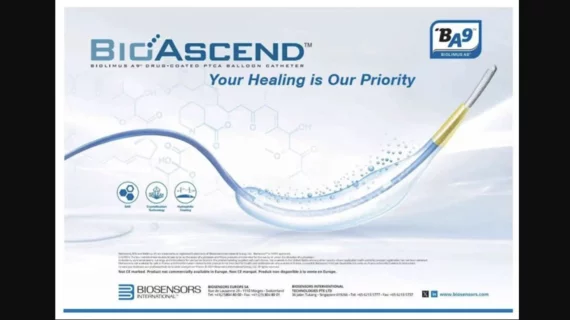In-stent restenosis after PCI: New biolimus-coated balloon non-inferior to paclitaxel devices
Using a new biolimus-coated balloon (BCB) to prevent coronary in-stent restenosis after percutaneous coronary intervention (PCI) may be non-inferior to using a paclitaxel-coated balloon (PCB), according to new research published in EuroIntervention.[1]
“The distinct advantage of drug-coated balloons is their ability to deliver medication without requiring a new stent implantation,” wrote first author Yundai Chen, MD, with the department of cardiology at The First Medical Center of Chinese PLA General Hospital in China, and colleagues. “This underscores the crucial significance of the advancing drug-coated balloon technology. Different drug-coating formulations and coating-process technologies will result in different vascular responses due to variations in drug formulation, dosage, pharmacokinetics and interactions with lesions.”
Prior comparisons between BCBs and PCBs have resulted in mixed findings. Chen et al. hoped to learn more with BIO ASCEND ISR, a randomized controlled trial exploring data from 280 PCI patients treated from December 2020 to January 2022. The mean patient age was 64 years old, 74.2% of patients were male and there were “no significant differences” between the two groups when it came to patient demographics or lesion characteristics.
All PCI patients were randomized to treatment with either a BCB or PCB. BCB patients were treated with the new Biolimus A9 Coated BioAscend balloon. The coating, Biolimus A9 (BA9), was developed by Biosensor International.
“BA9, a modified sirolimus analogue with increased lipophilicity, aims to optimize local drug delivery from stents and balloons,” the authors wrote. “Unlike sirolimus, BA9 is a crystallized drug with less drug loss during delivery and has 10 times more lipophilic solubility than sirolimus. This allows rapid absorption by tissues while minimizing exposure loss, resulting in more efficiency in inhibiting endovascular hyperplasia and reduction of late lumen loss.”
All PCB patients, meanwhile, were treated with the popular SeQuent Please NEO drug-coated balloon from B. Braun Melsungen AG.
Before randomization, patients were given aspirin in addition to clopidogrel or ticagrelor prior to PCI. They were told to continue dual antiplatelet therapy for at least one month after the procedure and keep taking aspirin going forward.
Overall, the study’s primary endpoint—mean in-segment late lumen loss after nine months—was 0.23 mm for the BCB group and 0.25 mm for the PCB group. The researchers also used optical coherence tomography (OCT) to track neointimal area after nine months; it was 2.32 mm2 for the BCB group and 2.37 mm2 for PCB group.
After one year, the group added, target lesion failure (13.3% vs. 9.5%) and revascularization (22.2% vs. 13.2%) were both higher in the BCB group. These differences were not found to be statistically significant, but Chen and colleagues did emphasize that larger studies with longer follow-up periods were needed to “provide a more comprehensive understanding of this matter.”
Reviewing these findings, the authors ultimately concluded that the BCB was non-inferior to the PCB when treating PCI patients with a drug-coated balloon.
“These results suggest the potential of BCBs to improve clinical outcomes in coronary in-stent restenosis treatment,” they wrote.
Read the full study here.

